Defying the doom-mongers - the SLK R170
Discussion
SLK230 – Linarite Blue - 1998 - Three owners – 90,000 miles
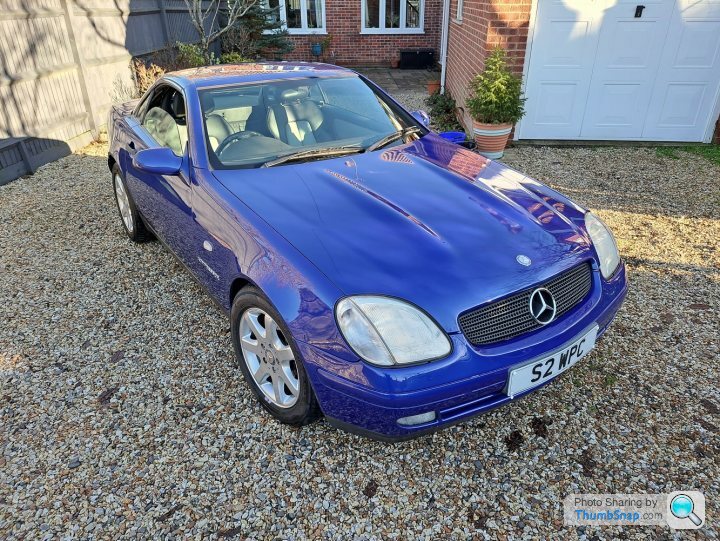
As Curator of my wife’s car collection I feel qualified to write about her SLK230.
Yes, all right, she only has one car but I clean it, put fuel in it, check its tyres and levels and orchestrate its maintenance. And I exercise it. When she's on her own, Mrs C rarely takes it further than to the shops and back, but I occasionally take it a bit further and a teensy bit faster. She always says how much better it feels after I’ve, ‘Given it a run.’ It’s nice to be appreciated. Insert nonchalant whistling smiley here.
The car was the solution to a problem of my own making. When we met in the early 90s and were getting to know one another, I asked the present Mrs C about her daydream car. I imagined she’d say a 205GTI or a Golf Cabriolet. We’d both received the rough end of divorces and I thought a sweeping gesture was due; a surprise present to move the relationship along. “Here you are, darling, I’ve bought you something.”
She told me her daydream car was the Pagoda SL. Ah. Good gracious. Is that so? Lovely. Very stylish. We bought a 205GTI. The introduction of the SLK a few years later came as a relief. Yes, I know it isn’t a Pagoda SL, but I felt it was more realistic as a daily.
At that time, the SLK wasn’t a car I’d have chosen for myself. The styling I liked, and I liked the idea of having a Mercedes - I’d never owned one – but the performance didn’t seem much to get excited about. But it wasn’t for me, it was for her, and ten years after the Pagoda SL conversation, we bought one. We still have it.
That was twenty years ago and despite my early misgivings I have grown to really like it. My wife loved it, she still loves it and we’ve kept it.
On the other hand, people who don’t like the early SLK really don’t like it. The shape, the steering, the handling, the performance, the interior. And rust. Wherever you look there’s talk about rust. This has always been a concern.
We bought the car in May 2002 from Mercedes in Clifton near Bristol. It was three and a half years old, 36,900 miles and my wife is the third owner. It was £22,350, the most I have ever paid for a car. According to the Bank of England inflation calculator, that equates to £38,000 today. At the time the SLK was trading at a premium.
Every now and then it does longer journeys. We live in Newbury, we have assorted kids in Manchester, Kent and the Rhondda and we sometimes take the SLK instead of my daily. As a fairly old car, it took us round France and Italy a couple of times with no bother at all. Until recently it had a Full Mercedes Benz Service History. It now has a Full Service History. We’ll talk about that.
The Mechanicals
Mechanically it has had very few issues; a cracked manifold which Mercedes replaced FOC early on, a gearbox problem where it wouldn’t change up out of first gear and the central locking having a party in the garage one night were the worst. MB had two attempts but couldn’t find the gearbox problem. Newbury Transmissions found a dodgy switch by the gear selector and replaced it. MB charged a chunk and said it was fixed but it wasn’t. In their defence the fault was intermittent.
One evening something orange was happening in the garage. I could see it through the garage window: flash, flash-flash, flash, flash-flash. The central locking couldn’t decide whether to be locked or unlocked. That was a few bob to sort out.
There was a minor problem with the roof, but I heard it in time and stopped the roof opening before it became a major problem. The nipple had slipped on one of the Bowden cables and a trim flap hadn’t retracted. I feared there would be much crushing and mangling. There may be sensors that detect resistance and stop the roof from self-destructing, I don’t know; I didn’t get that far. The mechanism is all a bit Heath Robinson to be honest. It works fine most of the time but there’s a lot going on behind the scenes.
The Body
Passive care: occasionally the car and I sit in the car wash on the premium cycle to benefit from the underbody spray, particularly during the salty months.
Active care: mostly I clean cars by hand. This enables me to keep an eye on rust and damage. To keep the car looking good it has been to several different body shops over the years for rust spots and dents. I missed one patch of rust which annoyed me, in a blind spot on the driver’s side C pillar next to the rear screen. When I found it, I had a go with blue Hammerite which, I discovered, is nothing like Linarite Blue. Unfortunately, the car is a ding magnet, I’ve no idea why. On one trip to the paint shop it had thirteen door dings: six on one side and seven on the other.
A more thorough part of my cleaning routine is every two or three years I remove the front wheel arch liners, remove the bolts along the bottom of the front wings, slacken the bolts in the door shuts, ease the wings out a bit at the bottom and hose out thoroughly.
The Interior
The interior is okay. A paint shop I used once that went out of business had a go at respraying the painted parts of the trim. It wasn’t very successful. A German company sell pots of interior touch up paint by mail order which is very good and unless you want a Concours car it is a better solution, I believe. Other than the seat heaters failing and being replaced, the seats are fine
The Chassis
Underneath the car was getting scruffy. No two ways about it. This was where I fell out with Mercedes. Four years ago, when I rang to book it in for a service the customer service operative (I’m assured that is the correct title) asked, “Do we know this car?” “You’ve serviced and maintained it for sixteen years.” “Have we? Oh.” Sigh.
Anyway, I took it in for the service and it came back with a video of a technician walking around underneath giving a commentary on things that in his opinion needed replacing. This is rusty and needs replacing, that’s rusty and needs replacing, those are rusty and need replacing. Several things occurred to me. You’ve serviced and maintained it for sixteen years; how did it get in this state? And, y’know, I can see rusty brake pipes should be replaced but rusty springs and rusty shock absorbers? Are the springs broken? No. Are the shock absorbers leaking? No. Do they work? Yes. Does it pass its MoT test? Yes. It didn’t look that bad to me.
That’s why four years ago the FMBSH became FSH as the car now goes to AutoMerc, an independent Mercedes specialist here in Newbury. With the benefit of hindsight, I wish I’d gone independent earlier.
Despite being irritable about the Mercedes technician’s video, this was the point where I decided the car needed to be refurbished. We knew the time would come eventually and this was it.
When I started the work, I knew what I was letting myself in for and bought another car to use while her rust-riddled car was incapacitated. Man Maths. Man Logic. Man wants another car and buys one.
Even though I was ready to find an abundance of rust to cure, the job was to be a refurbishment rather than restoration. We wanted to keep the car usable as much as possible during the work, but we also didn’t want to finish up with a car that was too good to be used. “Don’t turn it into a garage queen,” to quote Mrs C. Where on Earth did she learn a phrase like that? Also, as the car has been well maintained, I was pretty sure it didn’t need much mechanically.
Why did it take me so long? Was it lockdowns, Brexit, Ukraine? No, they didn’t really affect it. It was possibly because, rather than doing the work in one go and getting the car back on the road as quickly as we could, we weren’t in a rush and the job turned into a rolling refurb. In some way the job became Maintenance Plus; more of the same but with welding and paint thrown in. But possibly it was so I could keep for a bit longer the No.3 car I bought to use while her car was out of action. Insert another nonchalant whistling smiley here.
The refurbishment proposal:
Have any mechanical stuff done first. Find the rust, send it to the menders for a couple of weeks to have the rust cured, buy some new parts, send it off for a fortnight in the paint shop. Easy. There's a thing. We didn’t need the third car after all. Shame.
Not required for the refurbishment:
The interior is okay – needs a bit of a tidy up
Under the bonnet is okay – same again, could do with some elbow grease
Mechanically sound
Servicing up to date
Wheels and tyres are okay – wheels refurbished two or three times over 20 years, normal stuff
Required for the refurbishment:
Remove wheel arch liners and underbody shields
Remove bumpers and front wings – clean, repair and paint where necessary
Thoroughly check undersides – clean, repair and paint where necessary
New springs and shock absorbers - bought but not fitted yet – old ones scruffy but working
New front wings – the old ones survived 24 years
Repaint where necessary – most of the body as it turned out
New headlights - old ones knackered
New tail lights - not really required but I fancied the later type which are a stronger colour
Refit and Waxoil
Write report for PistonHeads
Yes, looking at the list, it’s a wonder it took so long.
REFURBISHMENT:
To AutoMerc for brake pipes, exhaust clamps and brackets etc
Initially, none of the businesses I spoke to wanted to do the underneath. But AutoMerc, who didn’t want to do it either, suggested Silchester Garage the local classic Mercedes specialist. Silchester had it for a couple of days and reported that there was surface rust but nothing to worry about. Hang on! It’s supposed to be a rusty colander. Where’s all the rust?
They didn’t do any welding but cleaned and painted the undersides and the chap who did it said he enjoyed doing it. Always a bonus. The part I was most concerned about was the rear subframe. Both Silchester Garage and AutoMerc say it’s fine. That’s good enough for me. Silchester also painted and fitted the four new stiffener braces I supplied.
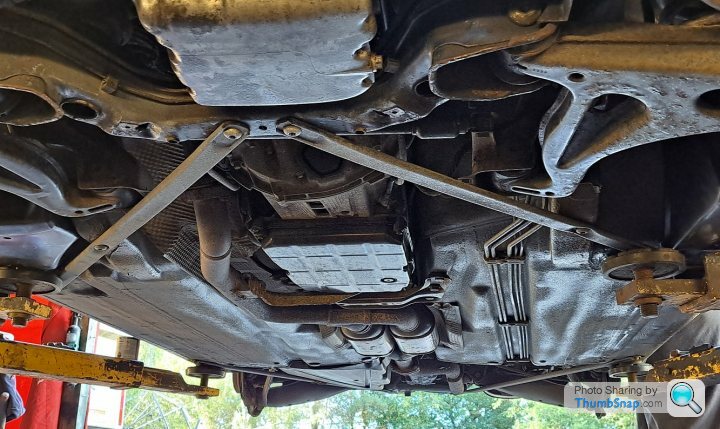
Picture taken nine months after Silchester Garage had cleaned and painted the undersides
Rusty bits. The front wings didn’t go rusty where I periodically clean behind them. They did go rusty where they met the front bumper; the bit I didn’t do. About five years ago a paint shop estimated for removing the bumpers, making good the returns on the wings front and back where they were starting to bubble and respraying where required. This was the same episode as the unsuccessful interior freshen up.
They didn’t take the bumpers off. It were all lies. It didn’t take long for the rust to return but by then the company had ceased trading. Bottom line, new front wings were required and, having broken two SLKs for parts, I knew that getting the old ones off isn’t as straightforward as it appears.
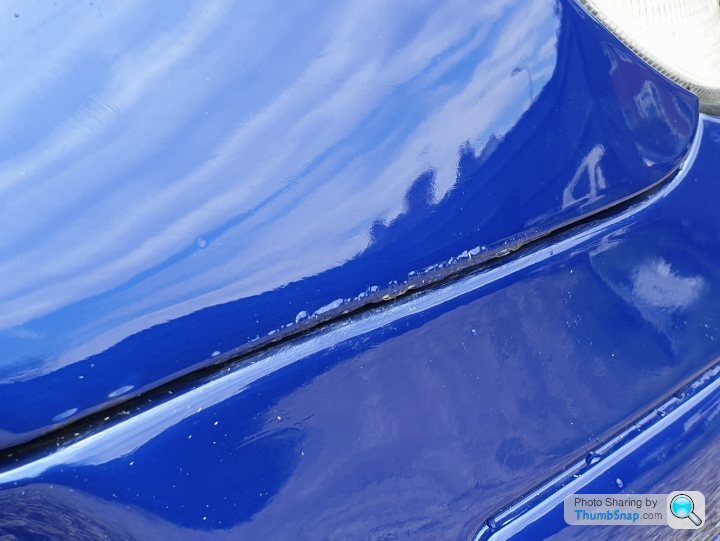
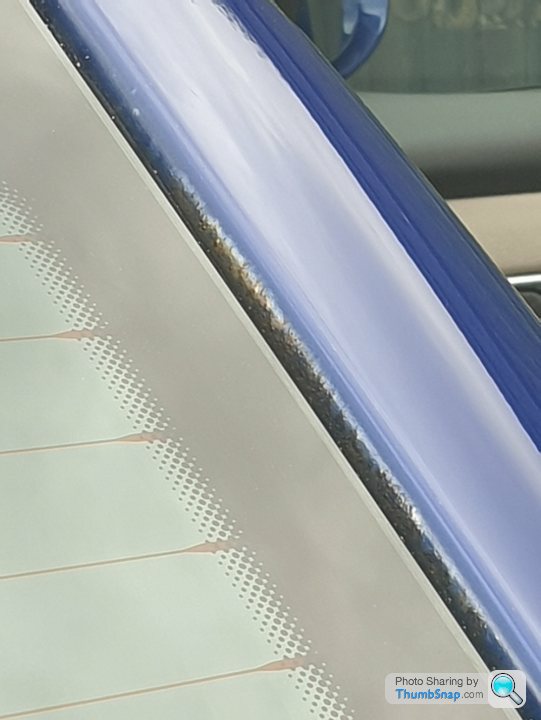
On the C pillar, just 'over the horizon' as you wash the car
The wheel arch liners and underbody shields were removed by me. In a rash moment before removing them I ordered replacements for most of them.
There was a really skanky bit each side aft of the headlights, concealed behind the front of the front wings. These were the brackets that join the wing, inner wing and bumper together and they were in a poor state. One side had rusted through and was in two bits. These were the bits I couldn’t reach as easily in my occasional wheel arch hose out. Couldn’t reach? Didn’t reach. Too difficult. Should have tried harder. This area is mentioned a lot in discussions on SLK websites. As far as I can tell, Mercedes never offered a repair patch for it. A German company made some good-looking replacements but seem to have stopped.
[url]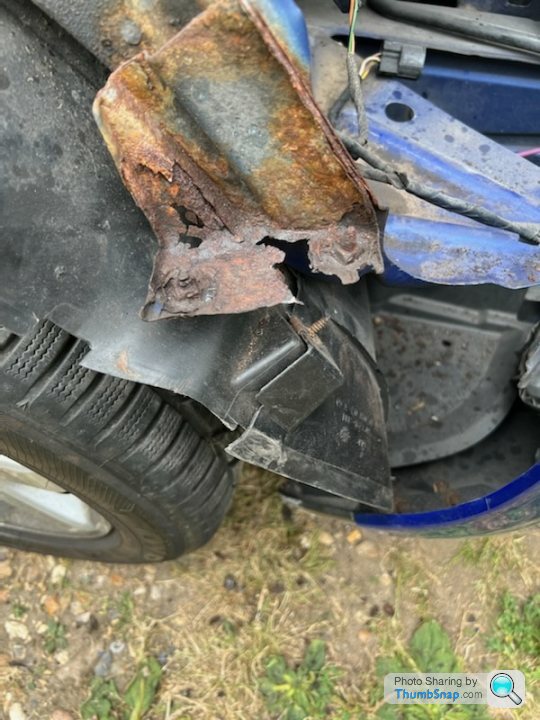
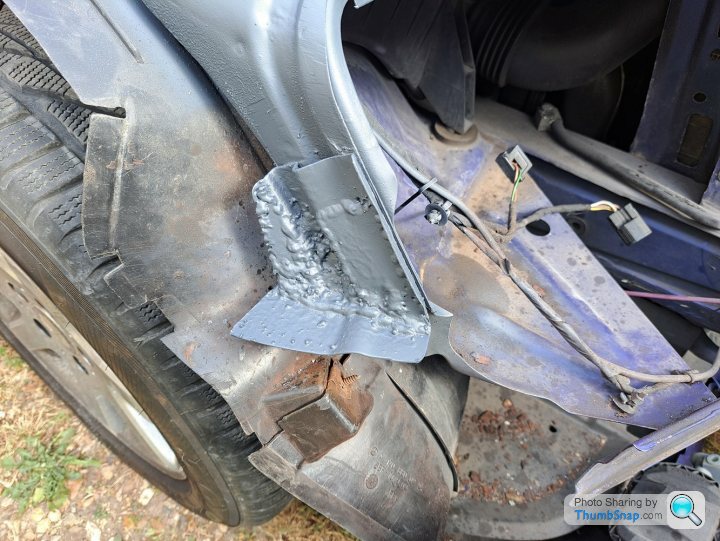
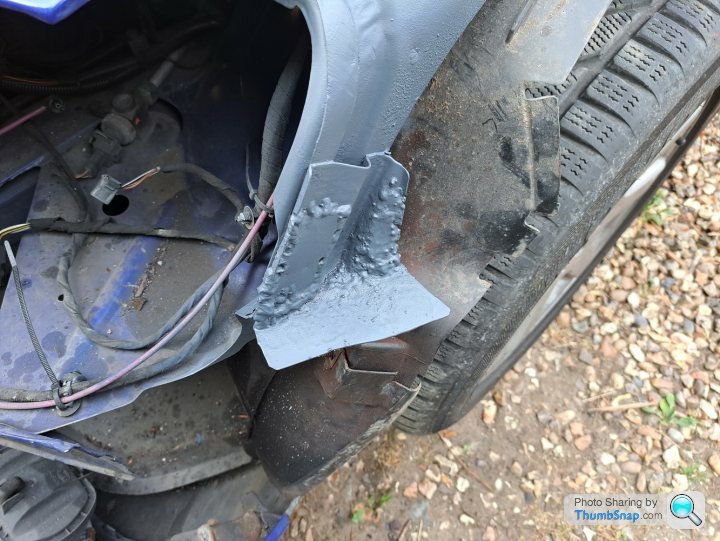
For some reason I didn't get a picture of the nearside one in two pieces. But it was.
Removal of both bumpers and front wings and the cleaning, repairing and painting where necessary was done by Andrew Jerome of APJ Vehicle Services in Easton near Newbury. He is a lifelong car man who was laid off during the Covid epidemic and set up on his own as a diagnostics specialist. He also does all those niggly jobs that owners and garages are reluctant to do. Knowing how obstinate the bumpers and front wings can be, Andy’s work would ease the job for the paintshop and make it all easier for me to remove next time. In future I’m going to take them off them every so often to ensure they will come off when the have to. He had to fabricate two or three unobtainable parts which he did in stainless but the rusted and broken brackets he mended in situ. This kept all the bits in their correct place. It ain’t pretty but it’s strong.
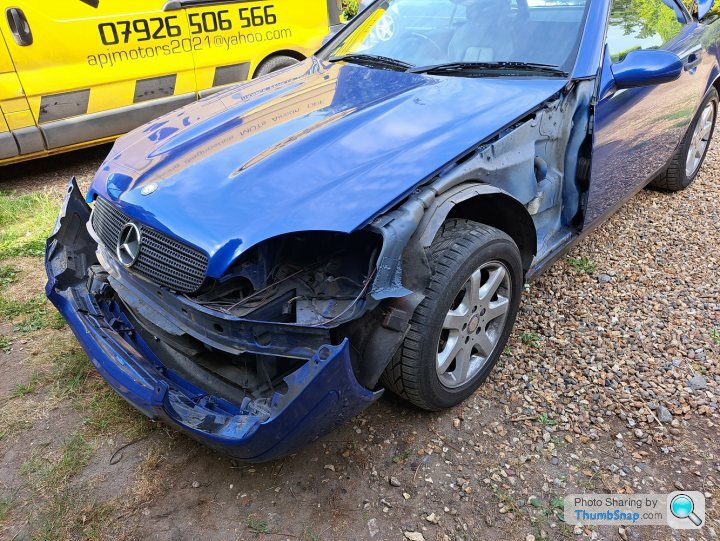
Back home, I took off the grille, headlights and front bumper. I wanted to clean the areas that would be difficult to get to after reassembly.
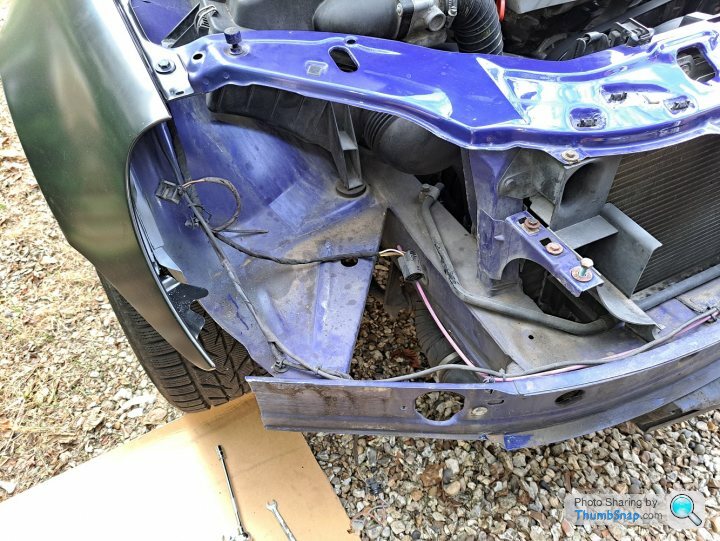
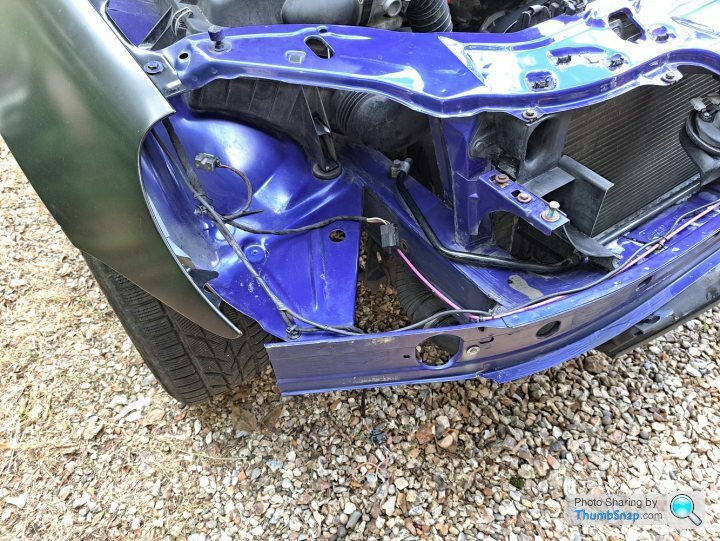
You'll notice how my role was reduced to Project Manager, cleaner and gopher. I could never weld, I can spray paint a bit and have years of practice as an amateur mechanic. Practically, I wasn't much use in the project. And I'm getting on a bit and grovelling about under cars in the front garden becomes increasingly less appealing.
My sons get fed up with hearing me say, "Do it while you're young, don't say you'll do it when you retire." Whatever it is, it is easier if you are in full command of your faculties. Here endeth today's lesson.
Between us we all missed a few areas of rust in the rear wheel arches - 'tubs' I learned we are supposed to call them. Typical. These were potentially the worst ones. I say that because they are disguised by layers of underseal and paint. You wouldn't see them in the early stages of decay if you weren't looking for them. There were three or four each side, mainly around grommets. The holes the grommets fill, as I understand it, are used for mechanical handling and alignment during the car's manufacture.

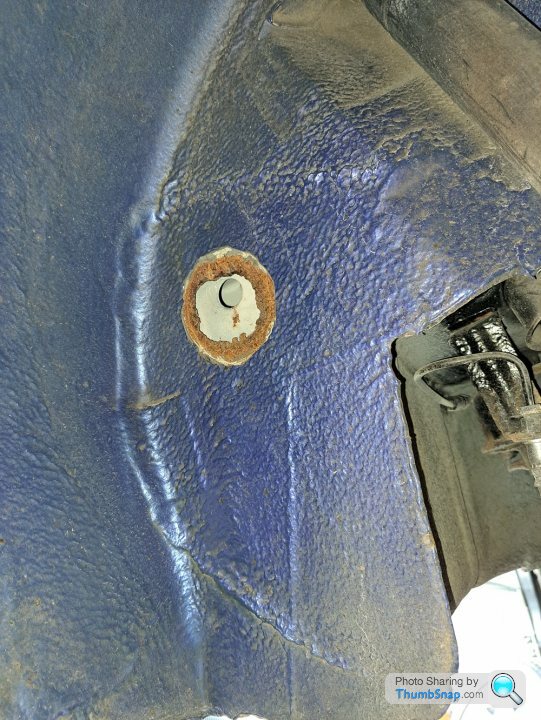
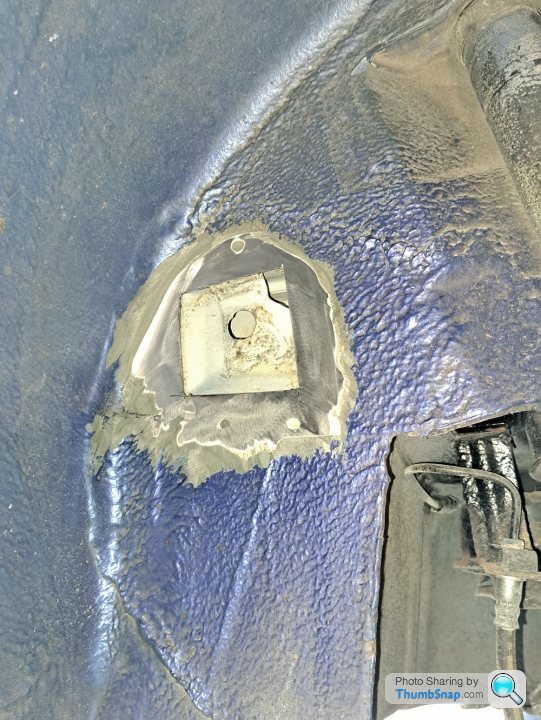
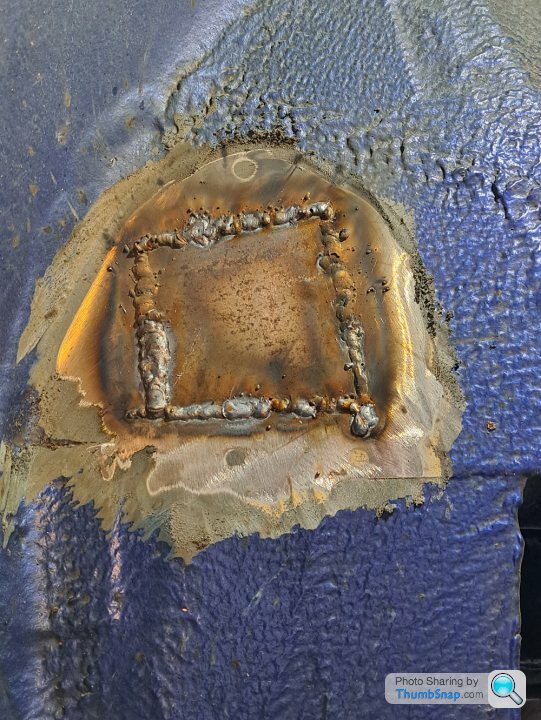
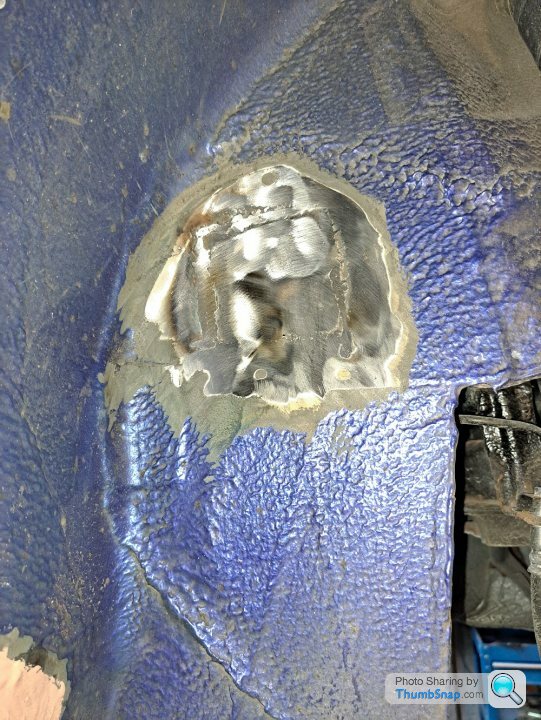
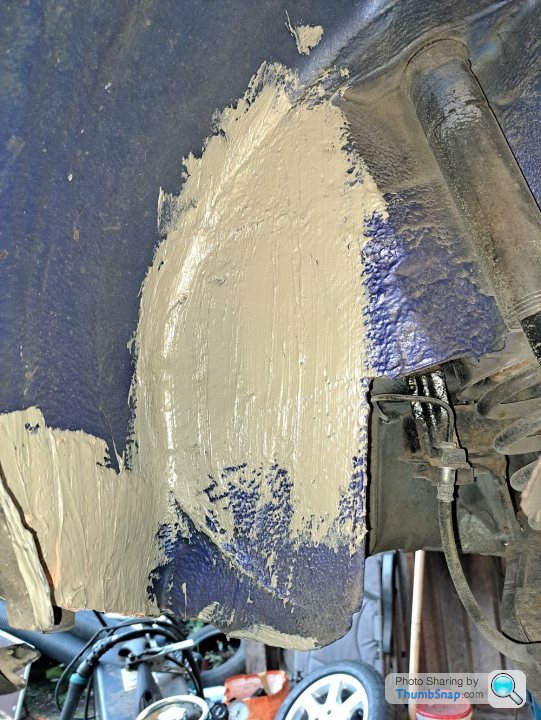
One of many at various stages of repair.
These were repaired by a friend of mine, Bradley Knott of Knott Racing near Aldermaston. I would have liked for him to have had more of the work but he’s a busy chap. If you live that way and would like to discuss some work with him, PM me and I’ll put you in touch.
The paint shop entrusted with the repainting was BMR Paint Shop in Newbury. They’ve done work for me before and do a good job. If you use them, be absolutely certain everything you want done is in the estimate. They are busy too and if it’s not on the list, they won’t do it. Could you squeeze that in while you’ve got the car? No. Can I book it back at another time? Yes.
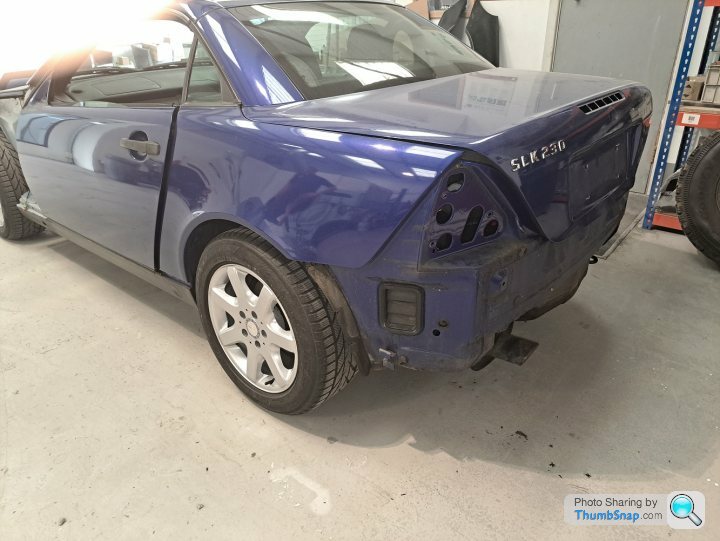
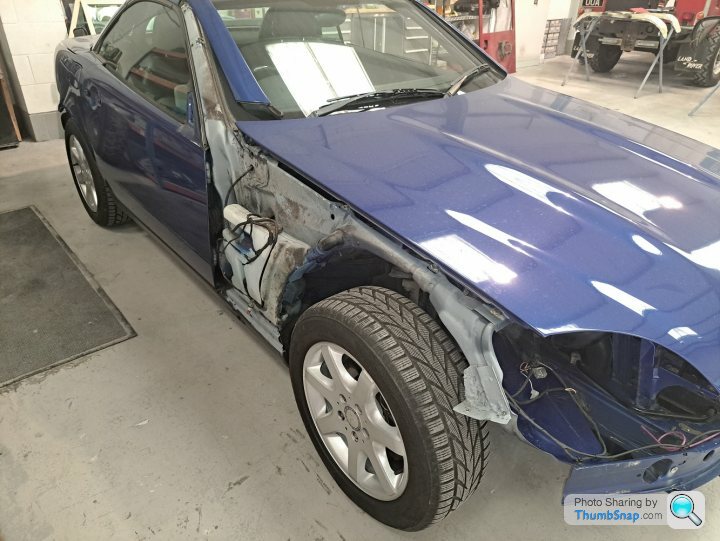
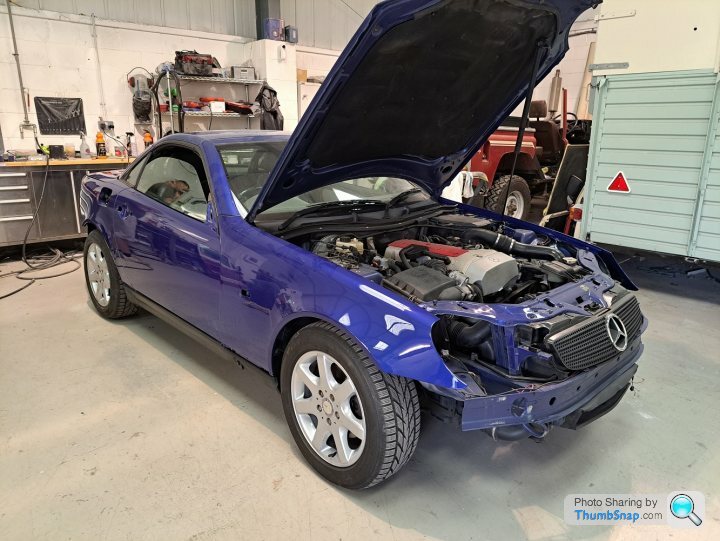
BMR did all the new bits and all the untidy bits on the body.
The wheels and tyres are the old winter set used as slaves. I decided against renewing the winter tyres as the car doesn't go out in slippery conditions. For me, slippery road behaviour is the worst aspect of the car. I forgot they were on when I took the car for MoT. It went through with an advisory on the side wall condition. I didn't tell the tester I thought they were scrap. They're still on the car now. We'll get a few more miles out of them and swap them in the Spring.
Then back home to refit some bits and bobs and there we are. Done.
Rust – try to keep on top of it.
Refurb cost
Clean and paint undersides - £250
Paint and fit new stiffener braces - £52
Make bumpers easily removable, repair rusty brackets,
fabricate stainless parts, ensure new front wings fit,
make good and paint where necessary - £900
Cut out rust, fabricate steel patches, weld and paint
in the rear tubs (mates rates) - £100
Repair and paint front and rear bumpers, rear arches,
OSR C-Pillar NS B-Pillar NS door, bootlid paint and fit
new front wings and blend adjacent panels for colour
matching, fit new rear lamps and badges - £3,360
Respray rear tubs - £120
Parts - £3,124
includes £440 for the front wings, £345 for later pattern
tail lamps (different price side to side) and - not yet fitted -
£963 for springs and shock absorbers and £842 for new
headlights and adaptors
REFURBISHMENT TOTAL = £7,906
Plus, debatably, AutoMerc for brake pipes, exhaust clamps and brackets etc
which could be classed as routine maintenance - £1,482
Why would anyone spend more on a car than it’s worth?
This was the question I asked myself in 1971 when I found out that two lads in the village where I grew up were meticulously restoring an Austin A30. I just couldn’t understand why anyone would take that amount of trouble with what I dismissed as an ordinary car. Me, the seventeen-year-old car snob, with 150mph dreams and a Frogeye Sprite.
Now, more than fifty years later, I have refurbished my wife’s old, run-of-the-mill SLK230 and I can sense the question being asked again. Mercedes built more than a hundred thousand SLK230s, why would anyone do that? Well, if we traded it and added £8,000 we couldn't get a car as nice in such good condition. But it's not just that.
You get attached to things. We’ve had the car a long time and it has become part of the landscape. With this bit of work it might do for another twenty years or so. If it does, it will see us out. We’ll both be in our nineties.
... ... ... ... ... ... ... ... ...
Shed had an R170 SLK recently.
Opinion among those responding to the article was, let’s say, broad. Some like it, many don’t, most are in between.
Those who dislike the car, dislike it a lot.
What the f**k were Mercedes at with their body work? The crap they produced back then makes me believe they don’t deserve any of my money spent on them. Their cars then were a total insult to their buyers. Make crap and sell it for loads.
To anyone tempted, I implore you, please don’t do it! Rust, bad electrics, numb steering, s te gearbox, central locking with a mind of its own, poor quality interior materials, the list goes on. Never never never never never again!
te gearbox, central locking with a mind of its own, poor quality interior materials, the list goes on. Never never never never never again!
Wouldn’t touch one of these with your mates-cousins-brothers barge pole. Dull. Rusty. Uninspired.
Eww. Ugly as sin.
Yeah, well, you can’t please everyone. There were a lot of positive posts as well. Where I thought there would only be love or hate, opinion wasn’t as polarised as I was expecting. And, in amongst it all, was inevitably…
Always found these cars are for people who cut hair.
The hairdresser’s car. Yes. Will the SLK ever escape that? Don’t know. It’s probably only a British thing anyway. If it limits the car’s desirability and keeps the prices down that would be a good thing for people who would like to own one.
If you want to bask in a car’s reflected glory, the R170 SLK is not for you. On the other hand, if you’d like a competent understated two-seater that’s at home almost anywhere then find a nice one and enjoy it.
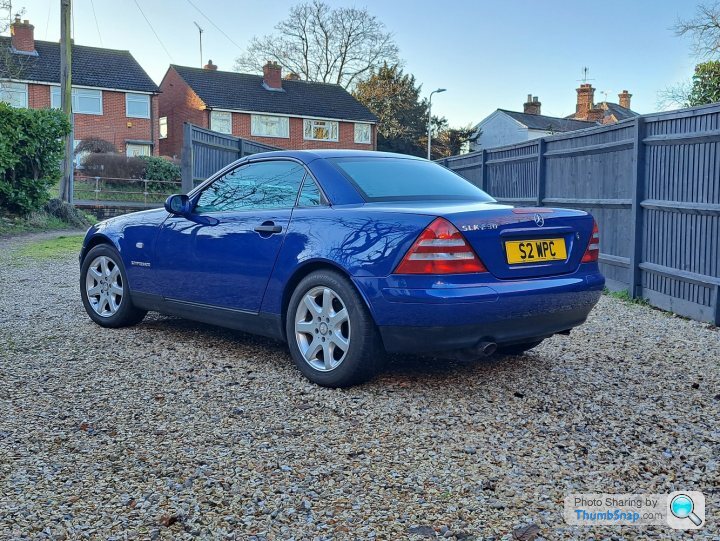
Simple, elegant lines. Timeless, I reckon.
... ... ... ... ... ... ... ... ...
The spare car to use during the refurb
When the time came to refurbish the car, any time the SLK spent off the road having work done would mean my wife would be without a car. Unless we bought another one, of course.
For as long as I can remember my plan was to buy an Aston when I retired. As the time approached, although I was in a position to buy a tired DB7, I didn’t do it. It wasn’t the money. Well, it was and it wasn’t. If I bought one, it would take the whole budget and that’s not a good idea. Either way, I just couldn’t do it. Instead of looking forward to driving to fabulous restaurants and expensive hotels, I could only foresee every variety of grief. Just being able to say the words, “We’ll take the Aston,” wasn’t enough. When I was in my twenties, I had a go at restoring a DB4. Ten years after buying it, during my divorce, I sold it in pieces. In the end I decided I wasn’t going to do anything remotely like that again. But I still wanted a project, a late life crisis car.
With the Aston dream derailed, what would be the ideal car for my retirement project? An added challenge was it would be a car with two roles; a project for me and transport for my wife when her car was off the road. It would need to be in ready-to-go condition, reliable, with DB7 performance, with a few things needing doing – not too many - and whose purchase left some money in the pot to do them. With the refurbishment of Mrs C’s SLK in mind it also had to be easily driveable by someone who has driven nothing but an R170 SLK for years. Hmm.
SLK32 – 2001 – Obsidian Black - Nine owners – 95,000 miles
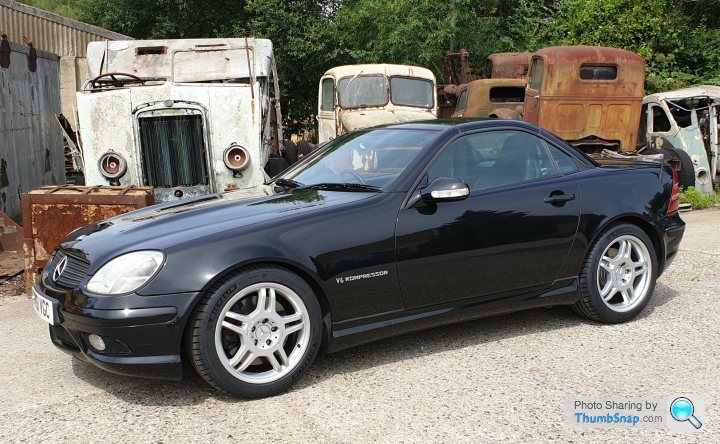
The SLK32 came from the Performance Car Company in Havant just before the first Covid lockdown. It was £7,900 with 8 owners and 85,000 miles.
Early on, wearing my disingenuous hat on, I wondered if Mrs C might say, “Ooh, this is nice, let’s keep this and sell the blue one.” It wasn’t going to happen. But that’s okay, I have another hat, a Stick-to-Plan-A hat.
Performance Cars had two SLK32s, both black. They were similar age, but one had less miles and considerably fewer owners. As my SLK32 was to be a project car, to be changed out of all recognition, the number of owners and the mileage was irrelevant and I went for the cheaper of the two.
As I prefer the look of the early cars, part of the project was to remove the body kit, change the bumpers and mirrors to the early type and Q car it a bit. No one would expect an early SLK to go like that. When the refurb of the 230 was complete I’d make the 32 simpler, lighter, faster. I’d dispense with the heavy central locking pump and the roof mechanism. I’d make it into a fixed head, a one-off Black Series R170.
I didn’t, of course. When I got to know the car and find out its capabilities, I decided it was fast enough. After everything I said and planned, I started to make an okay-ish standard car better. Not going to be a track day car. Not going to be a Q car. Not going to be a Black Series pastiche. The electric seats were not replaced with buckets. The roof was not welded closed and the mechanism thrown away. The central locking pump was not discarded. The steering wheel was not replaced with a Momo. All the air bags are still in place. And the car still weighs a tonne and a half.
But, unlike the 230, it does have best part of 350 bhp. Not twice as much power but getting on that way. Gadzooks, it’s quick. It’s the fastest car I’ve ever owned. And the brakes are absolutely phenomenal. It does still prefer fast flat corners to anything challenging. Because of its weight it doesn’t like being chucked around, so I don’t. The 230 with its wide wheels and tyres has amazing dry road grip. In the wet it’s okay. If it’s slippery, you use the daily. The 32 is more of the same. The wheels and tyres are slightly wider. The wheels are larger diameter to accommodate bigger brakes and the tyres are lower profile so the roll radius is about the same.
In full road trim I took it to Santa Pod with a gaggle of PHers. My best was 13.55 seconds at 110 mph. The 230 would have been nowhere. On one run I was up against Scrump, Moderator of this Parish, in his 996. It was close but Scrump was kind enough to concede defeat. But then he spoiled it by saying his car wasn’t at its best. Yeah, well, I had a full tank of fuel due to switching my brain off in a filling station approaching Poddington. Idiot. I wanted 13.4 and was only 0.15 seconds off. In the 90s I saw Richard Williams in a full-house RSW 7 litre V8 Aston Zagato run 13.4. The car cost more than my house. Running the same time in £8,000 worth of hairdresser’s car would have amused me no end.
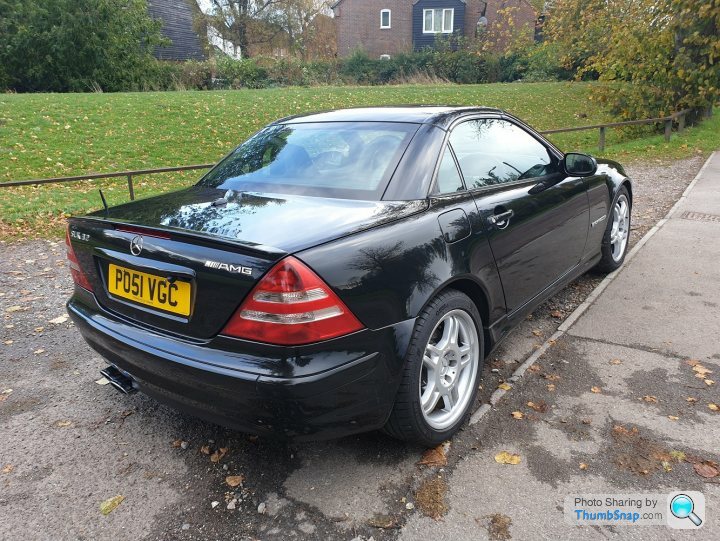
Preferring the look of the early car.
It’s often the case for me that the early version of a car looks better than its facelifts. The classic Range Rover and the Alfa Spider, for example. There are loads. An exception is the X type Jaguar which I think improved with the facelift. A facelift almost invariably means stuff bolted on and the cars becoming bulkier, and the original idea being compromised. A simple design like the original SLK becomes fussy. Don’t second-guess the designer, as my old dad used to say.
Having decided against altering the SLK32, what did it need? Tyres. The headrest wind deflector had gone, the centre console was cracked, the original stereo had been replaced by a slide-out screen Pioneer with reversing camera (Really? Yup. Fraid so) and the boot was a mess. It dripped oil a bit front and back. And the steering wheel doesn’t sit straight. Drives me nuts. Three attempts have been made to get it to sit right. I’m convinced places try to do all the adjustment on one side. If I get A Round Tuit I’ll have new track rod ends fitted and then they will have to adjust both sides. AutoMerc don’t do tracking. They put the work out to an outfit they trust but even they haven’t got it quite right.
A new wind deflector was bought, that was easy enough. The drips were costly to sort out. AutoMerc did the one at the front and Newbury Transmissions did the one at the back. At the front it was one of the rocker cover gaskets. AutoMerc did the gaskets both sides and advised there was another smaller leak where the crankcase oil seal was weeping. When I asked them to do it, they advised against, saying it wasn’t bad enough and didn’t warrant changing. “Just keep an eye on the oil level.” Okay. Actually, I keep an eye on the garage floor to see how the drip is progressing. It’s tiny, it’s fine.
Newbury Transmissions sorted out the drip at the back and fitted new discs and pads. The drip was an oil seal on the diff. I called in to have a look during the repair and was surprised to see a hefty but otherwise conventional differential. When I said I was surprised the diff wasn’t limited slip, the guvnor said the traction control sorts it out. It’s true, it does. I should have researched a bit before giving it beans the first time. It was the ease with which the traction control light came on was one of the reasons I abandoned my plans to make the car faster. By the time I had decided to keep the car standard I had fitted new tyres all round and the traction control light came on a lot less often. I can see now that none of my decision making was very logical.
As a consequence of the roof leaking a little on the passenger side, the 32 lives in the garage. The 230 lives outside at the moment. I have faith in the refurbishment, you see. The car was designed to be outside.
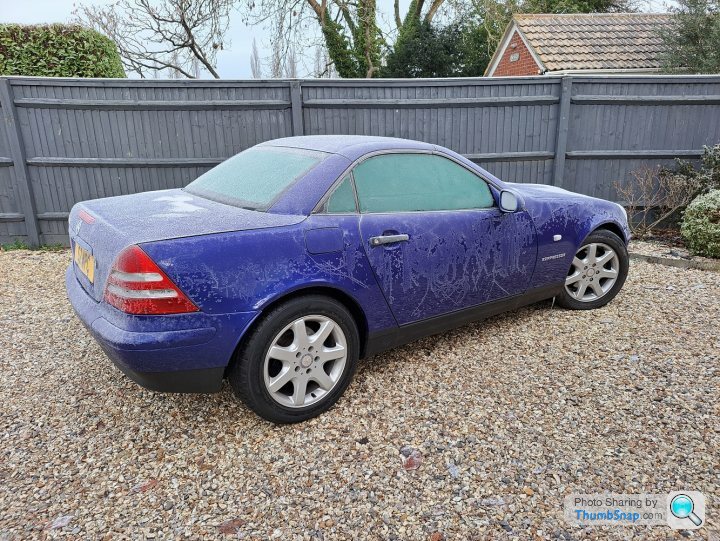
I'm not happy.
You're just a car. Get over it.
Main Dealer or Specialist?
When I took the SLK230, with its FMBSH, to AutoMerc for the first time, they came up with a substantial list of things that needed doing. When I took the SLK32 to AutoMerc for the first time, with its mostly specialist service history, the list was a lot shorter. Neither list was like the main dealer’s vague this-is-rusty-that’s-rusty video, they were both detailed.
Like most of the car’s major components, the exhaust on the 230 is original. Dismissively, MB said it was rusty and needed replacing. They didn’t share my pride in it surviving all those years. AutoMerc on the other hand said the exhaust itself was fine but needed new brackets and clamps.
Gordon, the AutoMerc supremo, test drives the cars himself and tells me both cars drive well. That’ll do for me.
The gearchange on the SLK32 I find a bit jerky around town. AMG modified the gearchange, both up and down, to be faster than on the standard car. This may be the cause of the jerkiness in stop/start traffic as the box tries to work out what's happening. Also, when pressing on, try to ration the kickdown. If you try for yet more acceleration at high revs it will kickdown but then it has to change up almost immediately and it doesn’t like that. Kickdown at lower revs is the way. Poodling along in a queue at low revs, see a gap and go for it is the sort of situation where the gearbox and engine combination excel.
The survival rate is astonishing:
263 UK spec cars were imported, How Many Left report 174 licenced and 82 SORN in Q2 2022.
That’s 256 of 263. Some may be imports but it’s impressive, nonetheless.
I’ve always enjoyed the joke about the GT40 – Of the 168 original cars built, only 242 survive today. We’re not at that state yet with the SLK32.
... ... ... ... ... ... ... ... ...
How do the two cars compare?
Chalk and cheese. You’ve heard the joke, no doubt: AMG took the early SLK, kept the body and threw everything else away. There’s many a true word spoken in jest. Outwardly similar but so different. The SLK230 is a good car that probably achieved everything Mercedes set out to achieve and which deserves a better reputation. The SLK32 is just astonishing. AMG did such a good job. It is a brilliant car that has slipped under the desirability radar for too long. Its day will come.
Neither of our two SLKs is a rusting hulk with a dismal history of mechanical and electrical failures. Don’t know why. Better than people anticipate? No idea.
Accept the R170 as a small grand-tourer-with-tyre-noise and you’ll get along fine.
In time, perhaps both will be more appealing as classics than they were as new cars.
Sadly, the SLK32 has to go. It has served its purpose and I enjoyed owning and driving it. We are going back to two cars, and I will have a more interesting car as my daily. That’s the answer, I think. I’ve had numerous quattros in various guises over the years from an A4 Avant Tdi quattro to an RS2. Interestingly, once you’re past the RS2’s party piece of 0 to 30 in 1.3 seconds, the SLK32 is quicker. I was surprised. The current clunker is an A4 Avant 1.8T quattro. Yes, an upgrade to a newer, interesting quattro estate will do me. Or a Jaguar X-type estate, the petrol versions are AWD. The X-type - there’s another car you don’t buy if you want to impress anyone. Or maybe turn the 1.8T into a project and make it better. Buy a leather interior and have the body tidied up. Yes, there's an idea.
Stop him, someone! He's gone mad!
I can’t help myself.

As Curator of my wife’s car collection I feel qualified to write about her SLK230.
Yes, all right, she only has one car but I clean it, put fuel in it, check its tyres and levels and orchestrate its maintenance. And I exercise it. When she's on her own, Mrs C rarely takes it further than to the shops and back, but I occasionally take it a bit further and a teensy bit faster. She always says how much better it feels after I’ve, ‘Given it a run.’ It’s nice to be appreciated. Insert nonchalant whistling smiley here.
The car was the solution to a problem of my own making. When we met in the early 90s and were getting to know one another, I asked the present Mrs C about her daydream car. I imagined she’d say a 205GTI or a Golf Cabriolet. We’d both received the rough end of divorces and I thought a sweeping gesture was due; a surprise present to move the relationship along. “Here you are, darling, I’ve bought you something.”
She told me her daydream car was the Pagoda SL. Ah. Good gracious. Is that so? Lovely. Very stylish. We bought a 205GTI. The introduction of the SLK a few years later came as a relief. Yes, I know it isn’t a Pagoda SL, but I felt it was more realistic as a daily.
At that time, the SLK wasn’t a car I’d have chosen for myself. The styling I liked, and I liked the idea of having a Mercedes - I’d never owned one – but the performance didn’t seem much to get excited about. But it wasn’t for me, it was for her, and ten years after the Pagoda SL conversation, we bought one. We still have it.
That was twenty years ago and despite my early misgivings I have grown to really like it. My wife loved it, she still loves it and we’ve kept it.
On the other hand, people who don’t like the early SLK really don’t like it. The shape, the steering, the handling, the performance, the interior. And rust. Wherever you look there’s talk about rust. This has always been a concern.
We bought the car in May 2002 from Mercedes in Clifton near Bristol. It was three and a half years old, 36,900 miles and my wife is the third owner. It was £22,350, the most I have ever paid for a car. According to the Bank of England inflation calculator, that equates to £38,000 today. At the time the SLK was trading at a premium.
Every now and then it does longer journeys. We live in Newbury, we have assorted kids in Manchester, Kent and the Rhondda and we sometimes take the SLK instead of my daily. As a fairly old car, it took us round France and Italy a couple of times with no bother at all. Until recently it had a Full Mercedes Benz Service History. It now has a Full Service History. We’ll talk about that.
The Mechanicals
Mechanically it has had very few issues; a cracked manifold which Mercedes replaced FOC early on, a gearbox problem where it wouldn’t change up out of first gear and the central locking having a party in the garage one night were the worst. MB had two attempts but couldn’t find the gearbox problem. Newbury Transmissions found a dodgy switch by the gear selector and replaced it. MB charged a chunk and said it was fixed but it wasn’t. In their defence the fault was intermittent.
One evening something orange was happening in the garage. I could see it through the garage window: flash, flash-flash, flash, flash-flash. The central locking couldn’t decide whether to be locked or unlocked. That was a few bob to sort out.
There was a minor problem with the roof, but I heard it in time and stopped the roof opening before it became a major problem. The nipple had slipped on one of the Bowden cables and a trim flap hadn’t retracted. I feared there would be much crushing and mangling. There may be sensors that detect resistance and stop the roof from self-destructing, I don’t know; I didn’t get that far. The mechanism is all a bit Heath Robinson to be honest. It works fine most of the time but there’s a lot going on behind the scenes.
The Body
Passive care: occasionally the car and I sit in the car wash on the premium cycle to benefit from the underbody spray, particularly during the salty months.
Active care: mostly I clean cars by hand. This enables me to keep an eye on rust and damage. To keep the car looking good it has been to several different body shops over the years for rust spots and dents. I missed one patch of rust which annoyed me, in a blind spot on the driver’s side C pillar next to the rear screen. When I found it, I had a go with blue Hammerite which, I discovered, is nothing like Linarite Blue. Unfortunately, the car is a ding magnet, I’ve no idea why. On one trip to the paint shop it had thirteen door dings: six on one side and seven on the other.
A more thorough part of my cleaning routine is every two or three years I remove the front wheel arch liners, remove the bolts along the bottom of the front wings, slacken the bolts in the door shuts, ease the wings out a bit at the bottom and hose out thoroughly.
The Interior
The interior is okay. A paint shop I used once that went out of business had a go at respraying the painted parts of the trim. It wasn’t very successful. A German company sell pots of interior touch up paint by mail order which is very good and unless you want a Concours car it is a better solution, I believe. Other than the seat heaters failing and being replaced, the seats are fine
The Chassis
Underneath the car was getting scruffy. No two ways about it. This was where I fell out with Mercedes. Four years ago, when I rang to book it in for a service the customer service operative (I’m assured that is the correct title) asked, “Do we know this car?” “You’ve serviced and maintained it for sixteen years.” “Have we? Oh.” Sigh.
Anyway, I took it in for the service and it came back with a video of a technician walking around underneath giving a commentary on things that in his opinion needed replacing. This is rusty and needs replacing, that’s rusty and needs replacing, those are rusty and need replacing. Several things occurred to me. You’ve serviced and maintained it for sixteen years; how did it get in this state? And, y’know, I can see rusty brake pipes should be replaced but rusty springs and rusty shock absorbers? Are the springs broken? No. Are the shock absorbers leaking? No. Do they work? Yes. Does it pass its MoT test? Yes. It didn’t look that bad to me.
That’s why four years ago the FMBSH became FSH as the car now goes to AutoMerc, an independent Mercedes specialist here in Newbury. With the benefit of hindsight, I wish I’d gone independent earlier.
Despite being irritable about the Mercedes technician’s video, this was the point where I decided the car needed to be refurbished. We knew the time would come eventually and this was it.
When I started the work, I knew what I was letting myself in for and bought another car to use while her rust-riddled car was incapacitated. Man Maths. Man Logic. Man wants another car and buys one.
Even though I was ready to find an abundance of rust to cure, the job was to be a refurbishment rather than restoration. We wanted to keep the car usable as much as possible during the work, but we also didn’t want to finish up with a car that was too good to be used. “Don’t turn it into a garage queen,” to quote Mrs C. Where on Earth did she learn a phrase like that? Also, as the car has been well maintained, I was pretty sure it didn’t need much mechanically.
Why did it take me so long? Was it lockdowns, Brexit, Ukraine? No, they didn’t really affect it. It was possibly because, rather than doing the work in one go and getting the car back on the road as quickly as we could, we weren’t in a rush and the job turned into a rolling refurb. In some way the job became Maintenance Plus; more of the same but with welding and paint thrown in. But possibly it was so I could keep for a bit longer the No.3 car I bought to use while her car was out of action. Insert another nonchalant whistling smiley here.
The refurbishment proposal:
Have any mechanical stuff done first. Find the rust, send it to the menders for a couple of weeks to have the rust cured, buy some new parts, send it off for a fortnight in the paint shop. Easy. There's a thing. We didn’t need the third car after all. Shame.
Not required for the refurbishment:
The interior is okay – needs a bit of a tidy up
Under the bonnet is okay – same again, could do with some elbow grease
Mechanically sound
Servicing up to date
Wheels and tyres are okay – wheels refurbished two or three times over 20 years, normal stuff
Required for the refurbishment:
Remove wheel arch liners and underbody shields
Remove bumpers and front wings – clean, repair and paint where necessary
Thoroughly check undersides – clean, repair and paint where necessary
New springs and shock absorbers - bought but not fitted yet – old ones scruffy but working
New front wings – the old ones survived 24 years
Repaint where necessary – most of the body as it turned out
New headlights - old ones knackered
New tail lights - not really required but I fancied the later type which are a stronger colour
Refit and Waxoil
Write report for PistonHeads
Yes, looking at the list, it’s a wonder it took so long.
REFURBISHMENT:
To AutoMerc for brake pipes, exhaust clamps and brackets etc
Initially, none of the businesses I spoke to wanted to do the underneath. But AutoMerc, who didn’t want to do it either, suggested Silchester Garage the local classic Mercedes specialist. Silchester had it for a couple of days and reported that there was surface rust but nothing to worry about. Hang on! It’s supposed to be a rusty colander. Where’s all the rust?
They didn’t do any welding but cleaned and painted the undersides and the chap who did it said he enjoyed doing it. Always a bonus. The part I was most concerned about was the rear subframe. Both Silchester Garage and AutoMerc say it’s fine. That’s good enough for me. Silchester also painted and fitted the four new stiffener braces I supplied.

Picture taken nine months after Silchester Garage had cleaned and painted the undersides
Rusty bits. The front wings didn’t go rusty where I periodically clean behind them. They did go rusty where they met the front bumper; the bit I didn’t do. About five years ago a paint shop estimated for removing the bumpers, making good the returns on the wings front and back where they were starting to bubble and respraying where required. This was the same episode as the unsuccessful interior freshen up.
They didn’t take the bumpers off. It were all lies. It didn’t take long for the rust to return but by then the company had ceased trading. Bottom line, new front wings were required and, having broken two SLKs for parts, I knew that getting the old ones off isn’t as straightforward as it appears.


On the C pillar, just 'over the horizon' as you wash the car
The wheel arch liners and underbody shields were removed by me. In a rash moment before removing them I ordered replacements for most of them.
There was a really skanky bit each side aft of the headlights, concealed behind the front of the front wings. These were the brackets that join the wing, inner wing and bumper together and they were in a poor state. One side had rusted through and was in two bits. These were the bits I couldn’t reach as easily in my occasional wheel arch hose out. Couldn’t reach? Didn’t reach. Too difficult. Should have tried harder. This area is mentioned a lot in discussions on SLK websites. As far as I can tell, Mercedes never offered a repair patch for it. A German company made some good-looking replacements but seem to have stopped.
[url]



For some reason I didn't get a picture of the nearside one in two pieces. But it was.
Removal of both bumpers and front wings and the cleaning, repairing and painting where necessary was done by Andrew Jerome of APJ Vehicle Services in Easton near Newbury. He is a lifelong car man who was laid off during the Covid epidemic and set up on his own as a diagnostics specialist. He also does all those niggly jobs that owners and garages are reluctant to do. Knowing how obstinate the bumpers and front wings can be, Andy’s work would ease the job for the paintshop and make it all easier for me to remove next time. In future I’m going to take them off them every so often to ensure they will come off when the have to. He had to fabricate two or three unobtainable parts which he did in stainless but the rusted and broken brackets he mended in situ. This kept all the bits in their correct place. It ain’t pretty but it’s strong.

Back home, I took off the grille, headlights and front bumper. I wanted to clean the areas that would be difficult to get to after reassembly.


You'll notice how my role was reduced to Project Manager, cleaner and gopher. I could never weld, I can spray paint a bit and have years of practice as an amateur mechanic. Practically, I wasn't much use in the project. And I'm getting on a bit and grovelling about under cars in the front garden becomes increasingly less appealing.
My sons get fed up with hearing me say, "Do it while you're young, don't say you'll do it when you retire." Whatever it is, it is easier if you are in full command of your faculties. Here endeth today's lesson.
Between us we all missed a few areas of rust in the rear wheel arches - 'tubs' I learned we are supposed to call them. Typical. These were potentially the worst ones. I say that because they are disguised by layers of underseal and paint. You wouldn't see them in the early stages of decay if you weren't looking for them. There were three or four each side, mainly around grommets. The holes the grommets fill, as I understand it, are used for mechanical handling and alignment during the car's manufacture.






One of many at various stages of repair.
These were repaired by a friend of mine, Bradley Knott of Knott Racing near Aldermaston. I would have liked for him to have had more of the work but he’s a busy chap. If you live that way and would like to discuss some work with him, PM me and I’ll put you in touch.
The paint shop entrusted with the repainting was BMR Paint Shop in Newbury. They’ve done work for me before and do a good job. If you use them, be absolutely certain everything you want done is in the estimate. They are busy too and if it’s not on the list, they won’t do it. Could you squeeze that in while you’ve got the car? No. Can I book it back at another time? Yes.



BMR did all the new bits and all the untidy bits on the body.
The wheels and tyres are the old winter set used as slaves. I decided against renewing the winter tyres as the car doesn't go out in slippery conditions. For me, slippery road behaviour is the worst aspect of the car. I forgot they were on when I took the car for MoT. It went through with an advisory on the side wall condition. I didn't tell the tester I thought they were scrap. They're still on the car now. We'll get a few more miles out of them and swap them in the Spring.
Then back home to refit some bits and bobs and there we are. Done.
Rust – try to keep on top of it.
Refurb cost
Clean and paint undersides - £250
Paint and fit new stiffener braces - £52
Make bumpers easily removable, repair rusty brackets,
fabricate stainless parts, ensure new front wings fit,
make good and paint where necessary - £900
Cut out rust, fabricate steel patches, weld and paint
in the rear tubs (mates rates) - £100
Repair and paint front and rear bumpers, rear arches,
OSR C-Pillar NS B-Pillar NS door, bootlid paint and fit
new front wings and blend adjacent panels for colour
matching, fit new rear lamps and badges - £3,360
Respray rear tubs - £120
Parts - £3,124
includes £440 for the front wings, £345 for later pattern
tail lamps (different price side to side) and - not yet fitted -
£963 for springs and shock absorbers and £842 for new
headlights and adaptors
REFURBISHMENT TOTAL = £7,906
Plus, debatably, AutoMerc for brake pipes, exhaust clamps and brackets etc
which could be classed as routine maintenance - £1,482
Why would anyone spend more on a car than it’s worth?
This was the question I asked myself in 1971 when I found out that two lads in the village where I grew up were meticulously restoring an Austin A30. I just couldn’t understand why anyone would take that amount of trouble with what I dismissed as an ordinary car. Me, the seventeen-year-old car snob, with 150mph dreams and a Frogeye Sprite.
Now, more than fifty years later, I have refurbished my wife’s old, run-of-the-mill SLK230 and I can sense the question being asked again. Mercedes built more than a hundred thousand SLK230s, why would anyone do that? Well, if we traded it and added £8,000 we couldn't get a car as nice in such good condition. But it's not just that.
You get attached to things. We’ve had the car a long time and it has become part of the landscape. With this bit of work it might do for another twenty years or so. If it does, it will see us out. We’ll both be in our nineties.
... ... ... ... ... ... ... ... ...
Shed had an R170 SLK recently.
Opinion among those responding to the article was, let’s say, broad. Some like it, many don’t, most are in between.
Those who dislike the car, dislike it a lot.
What the f**k were Mercedes at with their body work? The crap they produced back then makes me believe they don’t deserve any of my money spent on them. Their cars then were a total insult to their buyers. Make crap and sell it for loads.
To anyone tempted, I implore you, please don’t do it! Rust, bad electrics, numb steering, s
 te gearbox, central locking with a mind of its own, poor quality interior materials, the list goes on. Never never never never never again!
te gearbox, central locking with a mind of its own, poor quality interior materials, the list goes on. Never never never never never again!Wouldn’t touch one of these with your mates-cousins-brothers barge pole. Dull. Rusty. Uninspired.
Eww. Ugly as sin.
Yeah, well, you can’t please everyone. There were a lot of positive posts as well. Where I thought there would only be love or hate, opinion wasn’t as polarised as I was expecting. And, in amongst it all, was inevitably…
Always found these cars are for people who cut hair.
The hairdresser’s car. Yes. Will the SLK ever escape that? Don’t know. It’s probably only a British thing anyway. If it limits the car’s desirability and keeps the prices down that would be a good thing for people who would like to own one.
If you want to bask in a car’s reflected glory, the R170 SLK is not for you. On the other hand, if you’d like a competent understated two-seater that’s at home almost anywhere then find a nice one and enjoy it.

Simple, elegant lines. Timeless, I reckon.
... ... ... ... ... ... ... ... ...
The spare car to use during the refurb
When the time came to refurbish the car, any time the SLK spent off the road having work done would mean my wife would be without a car. Unless we bought another one, of course.
For as long as I can remember my plan was to buy an Aston when I retired. As the time approached, although I was in a position to buy a tired DB7, I didn’t do it. It wasn’t the money. Well, it was and it wasn’t. If I bought one, it would take the whole budget and that’s not a good idea. Either way, I just couldn’t do it. Instead of looking forward to driving to fabulous restaurants and expensive hotels, I could only foresee every variety of grief. Just being able to say the words, “We’ll take the Aston,” wasn’t enough. When I was in my twenties, I had a go at restoring a DB4. Ten years after buying it, during my divorce, I sold it in pieces. In the end I decided I wasn’t going to do anything remotely like that again. But I still wanted a project, a late life crisis car.
With the Aston dream derailed, what would be the ideal car for my retirement project? An added challenge was it would be a car with two roles; a project for me and transport for my wife when her car was off the road. It would need to be in ready-to-go condition, reliable, with DB7 performance, with a few things needing doing – not too many - and whose purchase left some money in the pot to do them. With the refurbishment of Mrs C’s SLK in mind it also had to be easily driveable by someone who has driven nothing but an R170 SLK for years. Hmm.
SLK32 – 2001 – Obsidian Black - Nine owners – 95,000 miles

The SLK32 came from the Performance Car Company in Havant just before the first Covid lockdown. It was £7,900 with 8 owners and 85,000 miles.
Early on, wearing my disingenuous hat on, I wondered if Mrs C might say, “Ooh, this is nice, let’s keep this and sell the blue one.” It wasn’t going to happen. But that’s okay, I have another hat, a Stick-to-Plan-A hat.
Performance Cars had two SLK32s, both black. They were similar age, but one had less miles and considerably fewer owners. As my SLK32 was to be a project car, to be changed out of all recognition, the number of owners and the mileage was irrelevant and I went for the cheaper of the two.
As I prefer the look of the early cars, part of the project was to remove the body kit, change the bumpers and mirrors to the early type and Q car it a bit. No one would expect an early SLK to go like that. When the refurb of the 230 was complete I’d make the 32 simpler, lighter, faster. I’d dispense with the heavy central locking pump and the roof mechanism. I’d make it into a fixed head, a one-off Black Series R170.
I didn’t, of course. When I got to know the car and find out its capabilities, I decided it was fast enough. After everything I said and planned, I started to make an okay-ish standard car better. Not going to be a track day car. Not going to be a Q car. Not going to be a Black Series pastiche. The electric seats were not replaced with buckets. The roof was not welded closed and the mechanism thrown away. The central locking pump was not discarded. The steering wheel was not replaced with a Momo. All the air bags are still in place. And the car still weighs a tonne and a half.
But, unlike the 230, it does have best part of 350 bhp. Not twice as much power but getting on that way. Gadzooks, it’s quick. It’s the fastest car I’ve ever owned. And the brakes are absolutely phenomenal. It does still prefer fast flat corners to anything challenging. Because of its weight it doesn’t like being chucked around, so I don’t. The 230 with its wide wheels and tyres has amazing dry road grip. In the wet it’s okay. If it’s slippery, you use the daily. The 32 is more of the same. The wheels and tyres are slightly wider. The wheels are larger diameter to accommodate bigger brakes and the tyres are lower profile so the roll radius is about the same.
In full road trim I took it to Santa Pod with a gaggle of PHers. My best was 13.55 seconds at 110 mph. The 230 would have been nowhere. On one run I was up against Scrump, Moderator of this Parish, in his 996. It was close but Scrump was kind enough to concede defeat. But then he spoiled it by saying his car wasn’t at its best. Yeah, well, I had a full tank of fuel due to switching my brain off in a filling station approaching Poddington. Idiot. I wanted 13.4 and was only 0.15 seconds off. In the 90s I saw Richard Williams in a full-house RSW 7 litre V8 Aston Zagato run 13.4. The car cost more than my house. Running the same time in £8,000 worth of hairdresser’s car would have amused me no end.

Preferring the look of the early car.
It’s often the case for me that the early version of a car looks better than its facelifts. The classic Range Rover and the Alfa Spider, for example. There are loads. An exception is the X type Jaguar which I think improved with the facelift. A facelift almost invariably means stuff bolted on and the cars becoming bulkier, and the original idea being compromised. A simple design like the original SLK becomes fussy. Don’t second-guess the designer, as my old dad used to say.
Having decided against altering the SLK32, what did it need? Tyres. The headrest wind deflector had gone, the centre console was cracked, the original stereo had been replaced by a slide-out screen Pioneer with reversing camera (Really? Yup. Fraid so) and the boot was a mess. It dripped oil a bit front and back. And the steering wheel doesn’t sit straight. Drives me nuts. Three attempts have been made to get it to sit right. I’m convinced places try to do all the adjustment on one side. If I get A Round Tuit I’ll have new track rod ends fitted and then they will have to adjust both sides. AutoMerc don’t do tracking. They put the work out to an outfit they trust but even they haven’t got it quite right.
A new wind deflector was bought, that was easy enough. The drips were costly to sort out. AutoMerc did the one at the front and Newbury Transmissions did the one at the back. At the front it was one of the rocker cover gaskets. AutoMerc did the gaskets both sides and advised there was another smaller leak where the crankcase oil seal was weeping. When I asked them to do it, they advised against, saying it wasn’t bad enough and didn’t warrant changing. “Just keep an eye on the oil level.” Okay. Actually, I keep an eye on the garage floor to see how the drip is progressing. It’s tiny, it’s fine.
Newbury Transmissions sorted out the drip at the back and fitted new discs and pads. The drip was an oil seal on the diff. I called in to have a look during the repair and was surprised to see a hefty but otherwise conventional differential. When I said I was surprised the diff wasn’t limited slip, the guvnor said the traction control sorts it out. It’s true, it does. I should have researched a bit before giving it beans the first time. It was the ease with which the traction control light came on was one of the reasons I abandoned my plans to make the car faster. By the time I had decided to keep the car standard I had fitted new tyres all round and the traction control light came on a lot less often. I can see now that none of my decision making was very logical.
As a consequence of the roof leaking a little on the passenger side, the 32 lives in the garage. The 230 lives outside at the moment. I have faith in the refurbishment, you see. The car was designed to be outside.

I'm not happy.
You're just a car. Get over it.
Main Dealer or Specialist?
When I took the SLK230, with its FMBSH, to AutoMerc for the first time, they came up with a substantial list of things that needed doing. When I took the SLK32 to AutoMerc for the first time, with its mostly specialist service history, the list was a lot shorter. Neither list was like the main dealer’s vague this-is-rusty-that’s-rusty video, they were both detailed.
Like most of the car’s major components, the exhaust on the 230 is original. Dismissively, MB said it was rusty and needed replacing. They didn’t share my pride in it surviving all those years. AutoMerc on the other hand said the exhaust itself was fine but needed new brackets and clamps.
Gordon, the AutoMerc supremo, test drives the cars himself and tells me both cars drive well. That’ll do for me.
The gearchange on the SLK32 I find a bit jerky around town. AMG modified the gearchange, both up and down, to be faster than on the standard car. This may be the cause of the jerkiness in stop/start traffic as the box tries to work out what's happening. Also, when pressing on, try to ration the kickdown. If you try for yet more acceleration at high revs it will kickdown but then it has to change up almost immediately and it doesn’t like that. Kickdown at lower revs is the way. Poodling along in a queue at low revs, see a gap and go for it is the sort of situation where the gearbox and engine combination excel.
The survival rate is astonishing:
263 UK spec cars were imported, How Many Left report 174 licenced and 82 SORN in Q2 2022.
That’s 256 of 263. Some may be imports but it’s impressive, nonetheless.
I’ve always enjoyed the joke about the GT40 – Of the 168 original cars built, only 242 survive today. We’re not at that state yet with the SLK32.
... ... ... ... ... ... ... ... ...
How do the two cars compare?
Chalk and cheese. You’ve heard the joke, no doubt: AMG took the early SLK, kept the body and threw everything else away. There’s many a true word spoken in jest. Outwardly similar but so different. The SLK230 is a good car that probably achieved everything Mercedes set out to achieve and which deserves a better reputation. The SLK32 is just astonishing. AMG did such a good job. It is a brilliant car that has slipped under the desirability radar for too long. Its day will come.
Neither of our two SLKs is a rusting hulk with a dismal history of mechanical and electrical failures. Don’t know why. Better than people anticipate? No idea.
Accept the R170 as a small grand-tourer-with-tyre-noise and you’ll get along fine.
In time, perhaps both will be more appealing as classics than they were as new cars.
Sadly, the SLK32 has to go. It has served its purpose and I enjoyed owning and driving it. We are going back to two cars, and I will have a more interesting car as my daily. That’s the answer, I think. I’ve had numerous quattros in various guises over the years from an A4 Avant Tdi quattro to an RS2. Interestingly, once you’re past the RS2’s party piece of 0 to 30 in 1.3 seconds, the SLK32 is quicker. I was surprised. The current clunker is an A4 Avant 1.8T quattro. Yes, an upgrade to a newer, interesting quattro estate will do me. Or a Jaguar X-type estate, the petrol versions are AWD. The X-type - there’s another car you don’t buy if you want to impress anyone. Or maybe turn the 1.8T into a project and make it better. Buy a leather interior and have the body tidied up. Yes, there's an idea.
Stop him, someone! He's gone mad!
I can’t help myself.
595Heaven said:
Great write up. Funny how attached you can get to a car isn’t it!
Thanks, 595. Believe it or not I'm a lot less sentimental about cars than I used to be. After I retired from engineering I had a couple of years doing driving jobs in the secondhand car business. It didn't quite cure me though. 
Hi Richard
I really enjoyed reading about your R170 SLKs. My wife has had the R171 version for the last 5 years or so. It has been pretty reliable though the hood has stopped going down recently ( and nobody in S Wales seems to be keen to look at the problem). Mrs O has unfortunately become troubled by chronic low back pain that is exacerbated by sitting in a low-slung sports car. In view of this we plan to sell her car in the Spring. If it were not for this problem the car would probably be a " keeper". Best Wishes
I really enjoyed reading about your R170 SLKs. My wife has had the R171 version for the last 5 years or so. It has been pretty reliable though the hood has stopped going down recently ( and nobody in S Wales seems to be keen to look at the problem). Mrs O has unfortunately become troubled by chronic low back pain that is exacerbated by sitting in a low-slung sports car. In view of this we plan to sell her car in the Spring. If it were not for this problem the car would probably be a " keeper". Best Wishes
Totally agree with your seemingly illogical logic. You’ve now got a cracking, super-exclusive car. I’m toying with the idea of doing the same things with my Subaru Outback which is an even less Pistonheads car than yours. Owned since new, mechanically A1 but some preventative maintenance and upgrades will keep it going another 10+ years. Most people on Pistonheads will tell me I’m mad and should buy a new car, but everything is boring these days. Great job.
Really enjoyed reading that.
You are so right about becoming attached to cars and them becoming part of the family. If you had spent the restoration cost of your wife’s car on buying a replacement, what on earth could you get for that amount. Money well spent, I’d say.
Hope you will keep us updated on both these SLKs.
You are so right about becoming attached to cars and them becoming part of the family. If you had spent the restoration cost of your wife’s car on buying a replacement, what on earth could you get for that amount. Money well spent, I’d say.
Hope you will keep us updated on both these SLKs.
What a great account of the care and £ you've invested into the original SLK R170.
Sounds like you wanted to do a job right, and I admire your patience.
Like you, I think they are under-appreciated. I'm perfectly happy with my 320 version, normally aspirated, not much to go wrong, and not slow. Also, I never take the roof for granted! Still a marvel.
Your AMG is the real McCoy. I have a want for one, but the bhp seems crazy to me. I think I'd plant my foot a bit too often. Such good value - your buyer is in for a treat.
Sounds like you wanted to do a job right, and I admire your patience.
Like you, I think they are under-appreciated. I'm perfectly happy with my 320 version, normally aspirated, not much to go wrong, and not slow. Also, I never take the roof for granted! Still a marvel.
Your AMG is the real McCoy. I have a want for one, but the bhp seems crazy to me. I think I'd plant my foot a bit too often. Such good value - your buyer is in for a treat.
tobinen said:
Great post. I am in Newbury too so it's good to hear about local workshops. I never quite gelled with AutoMerc and BMR but perhaps I will give then another go when the time comes.
It's funny you should say that, I can see why relationships with both AutoMerc and BMR could set off on the wrong foot. But Gordon, the guvnor at AutoMerc, is a very knowledgeable guy. And fair. He has discouraged me from spending money on a couple occasions which made me pause. It's so unusual.Indeed a great write up.
The R170 230 SLK is a underrated car imo. Nice size, good on go-go juice, parts are inexpensive and generally they don't give too much trouble bar the well known common issues.
The M111 Kompressor engine is bulletproof and has a lovely torque spread. Cheap and easy to take from the stock 190 BHP to 240 BHP+.
Good hunting on your next project car.
The R170 230 SLK is a underrated car imo. Nice size, good on go-go juice, parts are inexpensive and generally they don't give too much trouble bar the well known common issues.
The M111 Kompressor engine is bulletproof and has a lovely torque spread. Cheap and easy to take from the stock 190 BHP to 240 BHP+.
Good hunting on your next project car.
Edited by JJJ. on Sunday 8th January 22:51
Reluctantly, I went to a reunion of friends from growing up. My mate Tim's girlfriend and now wife of many years was always quick with put-downs. I wondered if she'd changed. This was before I had the SLK32 and I took my wife's SLK230. Did I mention you don't buy an SLK R170 to impress? Sure that the hairdresser line was coming, I had the wrong response rehearsed. She took one look at it and said, "Still interested in little sports cars, then?"
Little?
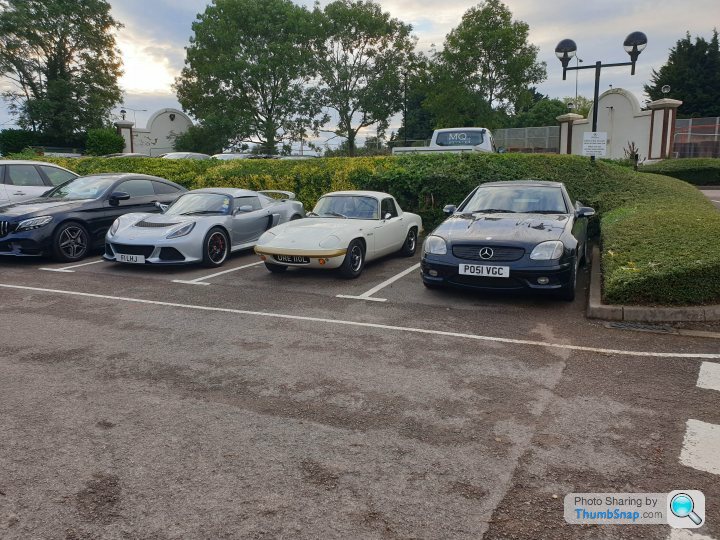
Depends on your perspective, I suppose.
This was en route to the Silverstone Classic in 2021.
Little?

Depends on your perspective, I suppose.
This was en route to the Silverstone Classic in 2021.
Gassing Station | Readers' Cars | Top of Page | What's New | My Stuff




